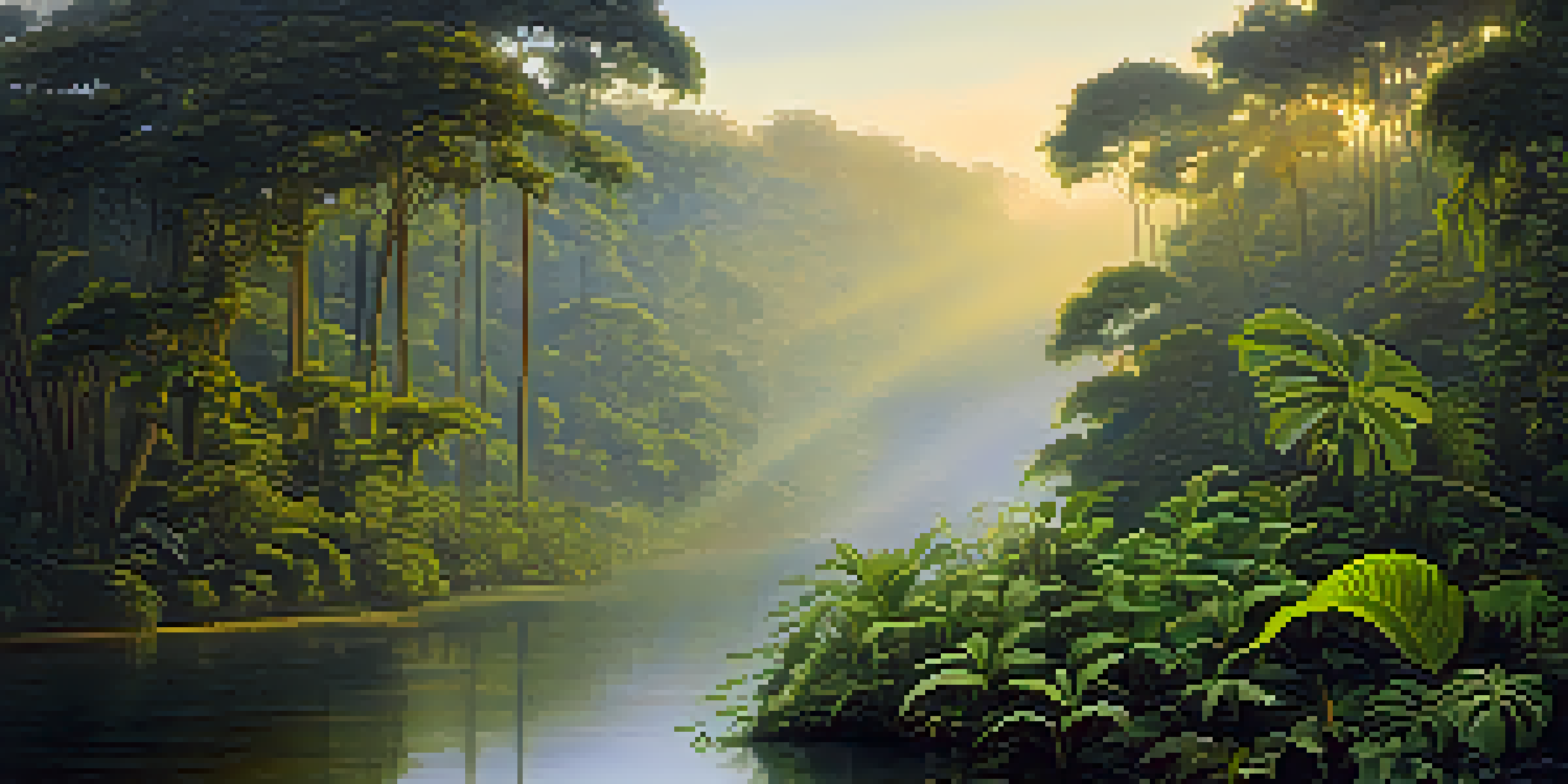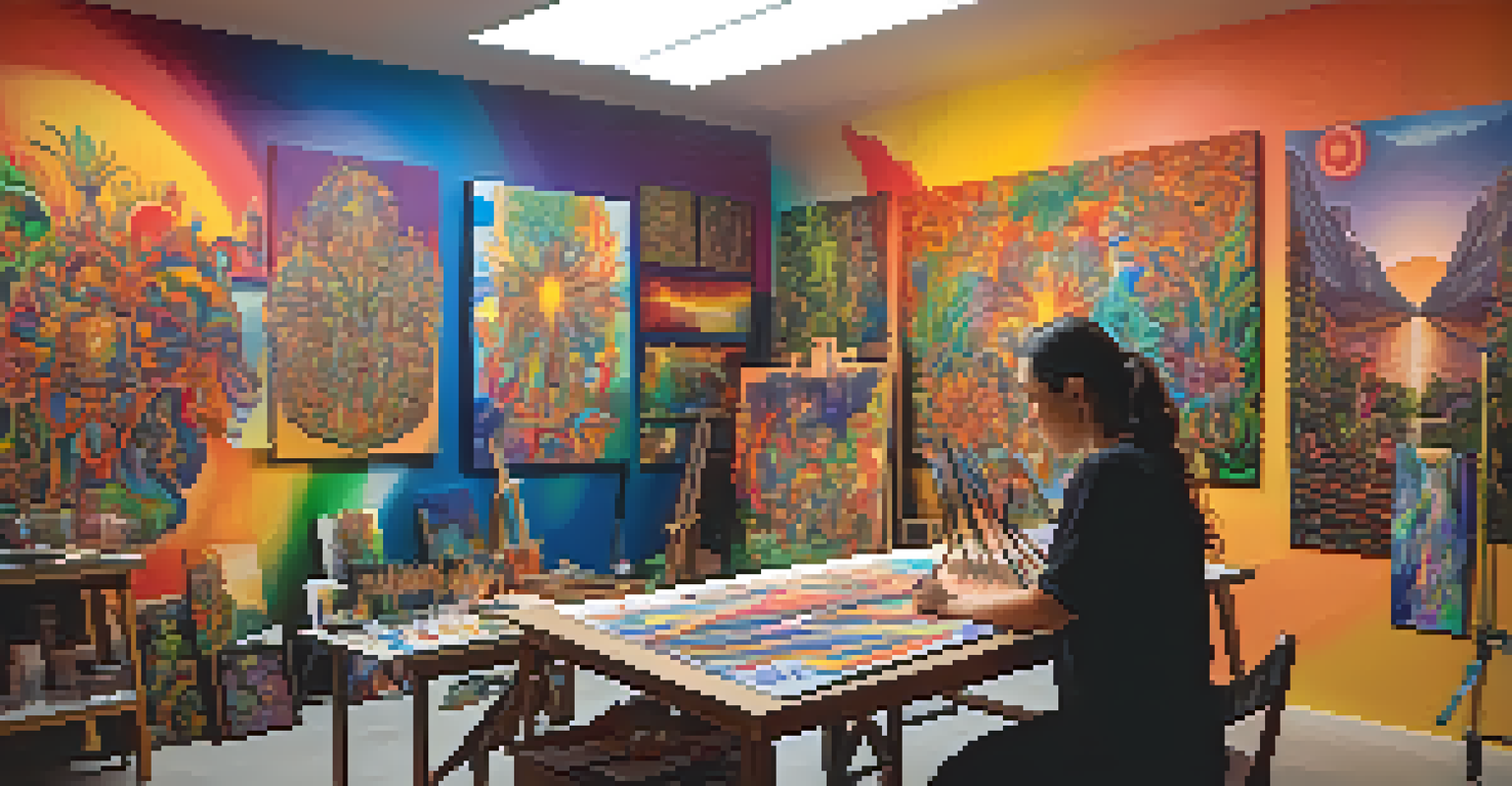Exploring the Therapeutic Aspects of Ayahuasca in Art

Understanding Ayahuasca and Its Cultural Roots
Ayahuasca is a traditional Amazonian brew that has been used for centuries in spiritual ceremonies. It typically contains two main ingredients: the Banisteriopsis caapi vine and the leaves of the Psychotria viridis plant. This combination creates a powerful psychedelic experience, often described as a journey into the self, which many believe can lead to profound insights and healing.
The experience of ayahuasca can lead to insights that are profoundly artistic, tapping into the very essence of creativity.
The cultural significance of ayahuasca is deeply rooted in indigenous practices, where it’s used not just for recreation, but as a sacred tool for healing and guidance. The shamans who facilitate these ceremonies play a crucial role, guiding participants through their experiences and helping them interpret the visions they encounter. This sacred context sets the stage for ayahuasca's therapeutic potential, particularly in the realm of creative expression.
As more people from diverse backgrounds begin to explore ayahuasca, its therapeutic aspects are becoming increasingly recognized in modern psychology and wellness circles. The intersection of ayahuasca, art, and healing presents a fascinating area of exploration that invites us to consider how altered states of consciousness can enhance creativity and self-expression.
The Therapeutic Effects of Ayahuasca on Creativity
Many artists and creators have reported significant shifts in their perspective and creativity after participating in ayahuasca ceremonies. The psychedelic experience often breaks down mental barriers, allowing individuals to access deeper layers of their consciousness. This newfound clarity can lead to fresh ideas, innovative concepts, and a more profound connection to one's artistic work.

For example, some musicians have described how ayahuasca has helped them tap into emotions and experiences they had previously struggled to express through their art. By breaking through these emotional barriers, artists can channel their experiences into their work, resulting in art that resonates on a deeper level with audiences. It’s as if ayahuasca opens a door to a creative well that had long been closed.
Ayahuasca Enhances Creative Insights
Participants often experience profound shifts in creativity and perspective following ayahuasca ceremonies.
Moreover, the introspective nature of the ayahuasca experience can foster a sense of authenticity in an artist's work. When individuals confront their personal struggles and traumas, they often emerge with a clearer understanding of their identity, which can translate into more honest and powerful art.
Art as a Medium for Processing Ayahuasca Experiences
After undergoing an ayahuasca ceremony, many participants feel compelled to create art that reflects their journey. This artistic expression can serve as a vital tool for processing their experiences and emotions. Whether through painting, writing, or music, the act of creation can help individuals integrate their insights and revelations into their everyday lives.
Art enables us to find ourselves and lose ourselves at the same time, often influenced by experiences that transcend ordinary perception.
For instance, artists might create visual art that embodies the vivid imagery experienced during their journey or write songs that capture the emotional depth of their insights. This practice not only aids in personal healing but also allows others to connect with the artist’s experience, creating a shared space for reflection and understanding.
In this way, art becomes a bridge between the personal and the universal. By sharing their stories through creative outlets, artists can inspire others to explore their own experiences with ayahuasca or similar journeys, fostering a community of healing and expression.
The Role of Community in Ayahuasca and Art
Community is a vital component of the ayahuasca experience, often enhancing both the therapeutic and artistic outcomes. Participants in ceremonies frequently form bonds with one another, sharing their stories and insights in a supportive environment. This camaraderie can lead to collaborative artistic endeavors, where individuals inspire and uplift each other’s creative journeys.
In many cases, artists who have undergone ayahuasca ceremonies come together to create collective works that reflect their shared experiences. This collaboration can amplify the healing effects of ayahuasca, as artists navigate their transformations together, encouraging one another to explore new styles and techniques in their art.
Art Reflects Ayahuasca Journeys
Creating art after an ayahuasca experience helps individuals process and share their insights with others.
Moreover, communal art projects can serve as a platform for discussing the complexities of the ayahuasca experience, breaking down stigmas and fostering understanding. By working together, artists can create a narrative that resonates with a broader audience, inviting more people to explore the therapeutic potential of ayahuasca in their own lives.
Challenges and Ethical Considerations in Ayahuasca Art
While the therapeutic aspects of ayahuasca in art are compelling, there are challenges and ethical considerations that must be addressed. The commercialization of ayahuasca experiences and the art that emerges from them can lead to the appropriation of indigenous cultures and practices. It’s essential to approach this topic with respect and awareness of the cultural significance behind ayahuasca.
Artists and participants should be mindful of how they represent their experiences and the potential impact on the communities that have traditionally used ayahuasca as a sacred tool. Open discussions about cultural sensitivity and ethical practices can help ensure that the narratives shared are respectful and inclusive.
Furthermore, it’s crucial to acknowledge that not everyone will have the same experience with ayahuasca. While some may find profound healing, others might encounter challenging emotions or difficult truths. Acknowledging these diverse experiences helps to create a more nuanced understanding of the relationship between ayahuasca and art.
Integrating Ayahuasca Insights into Daily Life and Art
The insights gained from an ayahuasca experience can linger long after the ceremony is over. Many individuals find themselves contemplating their revelations, leading to changes in their personal lives as well as their artistic practices. Integrating these insights into daily life can be a transformative process, often resulting in more profound and meaningful work.
For artists, this means not only creating art that reflects their experiences but also using those experiences to influence their creative approach. They might adopt new techniques, explore different themes, or even shift their artistic goals to align with their newfound understanding of self.
Community Strengthens Healing Through Art
Shared experiences in ayahuasca ceremonies foster community bonds, enhancing both artistic expression and therapeutic outcomes.
Additionally, maintaining a practice of reflection—whether through journaling, meditation, or continued artistic expression—can help solidify the lessons learned through ayahuasca. This ongoing integration process allows artists to create work that is not only a reflection of their inner journeys but also a source of inspiration for others.
Future Directions: Research and Exploration in Ayahuasca Art
As interest in ayahuasca continues to grow, so does the need for research into its therapeutic effects on creativity and art. Scholars and practitioners alike are beginning to explore the psychological and emotional benefits of these experiences, seeking to understand how they can be harnessed for healing and self-expression.
Future studies may delve deeper into the specific ways ayahuasca influences artistic processes, examining how different artistic mediums respond to the insights gained during ceremonies. This research could provide valuable information for therapists and artists, guiding them in using ayahuasca as a tool for healing and creativity.

Moreover, fostering a dialogue between artists, therapists, and researchers can create a richer understanding of the connections between ayahuasca, art, and personal healing. As this conversation evolves, we may uncover new opportunities for artistic expression and community building, paving the way for future generations of artists to explore their inner landscapes.